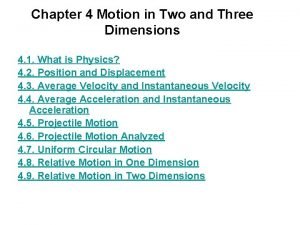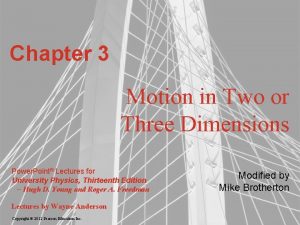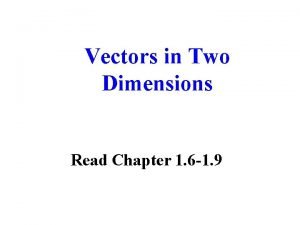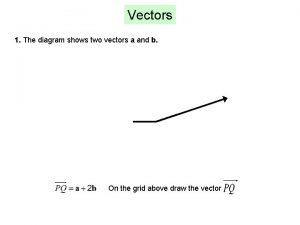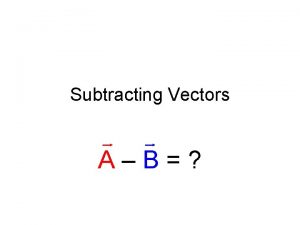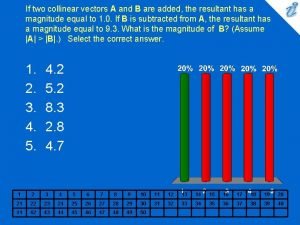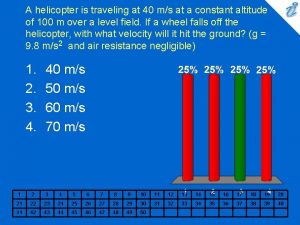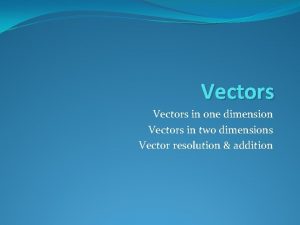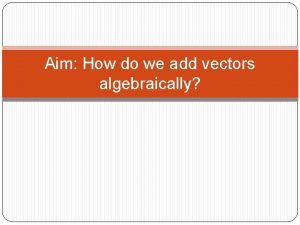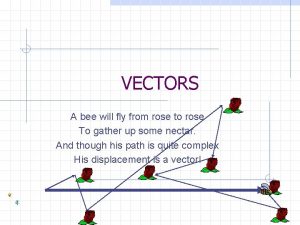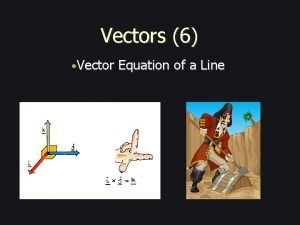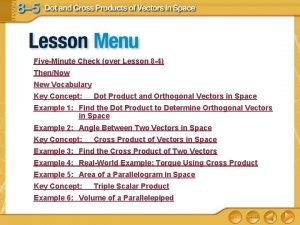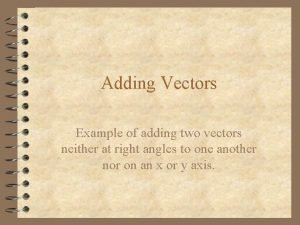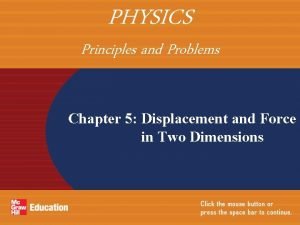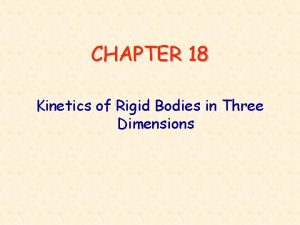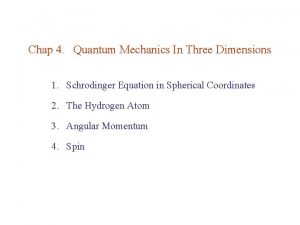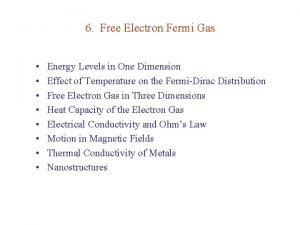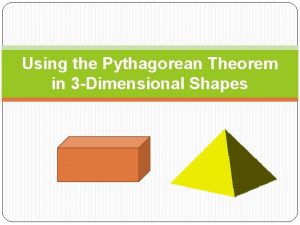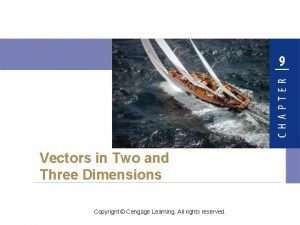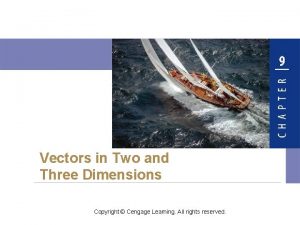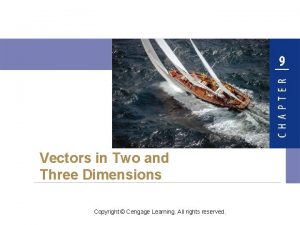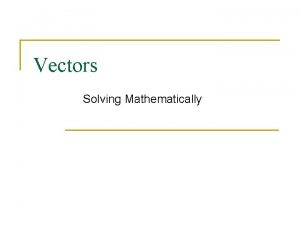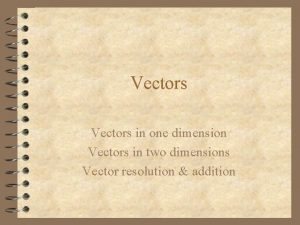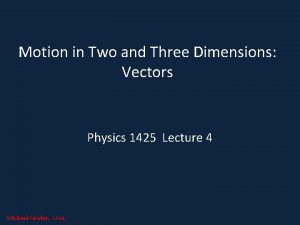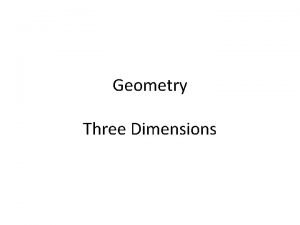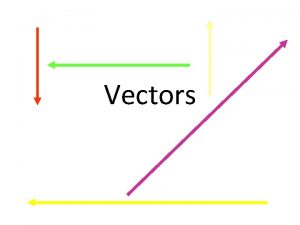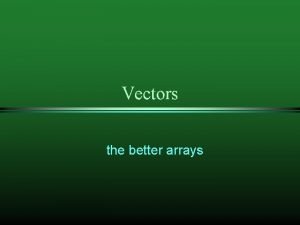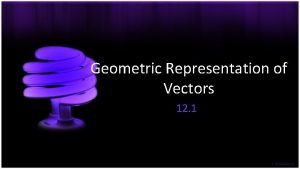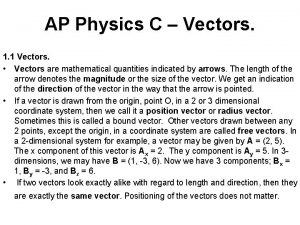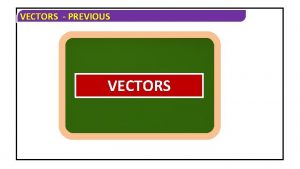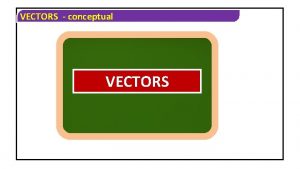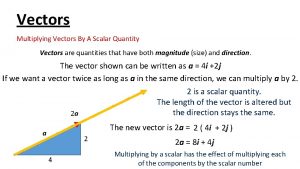Vectors in Two and Three Dimensions Copyright Cengage




































- Slides: 36

Vectors in Two and Three Dimensions Copyright © Cengage Learning. All rights reserved.

9. 2 The Dot Product Copyright © Cengage Learning. All rights reserved.

Objectives ► The Dot Product of Vectors ► The Component of u Along v ► The Projection of u Onto v ► Work 3

The Dot Product In this section we define an operation on vectors called the dot product. This concept is especially useful in calculus and in applications of vectors to physics and engineering. 4

The Dot Product of Vectors 5

The Dot Product of Vectors We begin by defining the dot product of two vectors. Thus to find the dot product of u and v, we multiply corresponding components and add. The dot product is not a vector; it is a real number, or scalar. 6

Example 1 – Calculating Dot Products (a) If u = 3, – 2 and v = 4, 5 then u v = (3)(4) + (– 2)(5) =2 (b) If u = 2 i + j and v = 5 i – 6 j, then u v = (2)(5) + (1)(– 6) =4 7

The Dot Product of Vectors The following are the properties of the dot product. 8

The Dot Product of Vectors Let u and v be vectors, and sketch them with initial points at the origin. We define the angle between u and v to be the smaller of the angles formed by these representations of u and v (see Figure 1). Thus 0 . The next theorem relates the angle between two vectors to their dot product. Figure 1 9

The Dot Product of Vectors The Dot Product Theorem is useful because it allows us to find the angle between two vectors if we know the components of the vectors. 10

The Dot Product of Vectors The angle is obtained simply by solving the equation in the Dot Product Theorem for cos . We state this important result explicitly. 11

Example 2 – Finding the Angle Between Two Vectors Find the angle between the vectors u = 2, 5 and v = 4, – 3 Solution: By the formula for the angle between two vectors we have Thus the angle between u and v is 12

The Dot Product of Vectors Two nonzero vectors u and v are called perpendicular, or orthogonal, if the angle between them is /2. The following theorem shows that we can determine whether two vectors are perpendicular by finding their dot product. 13

Example 3 – Checking Vectors for Perpendicularity Determine whether the vectors in each pair are perpendicular. (a) u = 3, 5 and v = 2, – 8 (b) u = 2, 1 and v = – 1, 2 Solution: (a) u v = (3)(2) + (5)(– 8) = – 34 0, so u and v are not perpendicular. (b) u v = (2)(– 1) + (1)(2) = 0, so u and v are perpendicular. 14

The Component of u Along v 15

The Component of u Along v The component of u along v (or the component of u in the direction of v) is defined to be | u | cos where is the angle between u and v. Figure 3 gives a geometric interpretation of this concept. Figure 3 16

The Component of u Along v Intuitively, the component of u along v is the magnitude of the portion of u that points in the direction of v. Notice that the component of u along v is negative if /2 < . In analyzing forces in physics and engineering, it’s often helpful to express a vector as a sum of two vectors lying in perpendicular directions. For example, suppose a car is parked on an inclined driveway as in Figure 4 17

The Component of u Along v The weight of the car is a vector w that points directly downward. We can write w=u+v where u is parallel to the driveway and v is perpendicular to the driveway. The vector u is the force that tends to roll the car down the driveway, and v is the force experienced by the surface of the driveway. The magnitudes of these forces are the components of w along u and v, respectively. 18

Example 4 – Resolving a Force into Components A car weighing 3000 lb is parked on a driveway that is inclined 15 to the horizontal, as shown in Figure 5 (a) Find the magnitude of the force required to prevent the car from rolling down the driveway. (b) Find the magnitude of the force experienced by the driveway due to the weight of the car. 19

Example 4 – Solution The car exerts a force w of 3000 lb directly downward. We resolve w into the sum of two vectors u and v, one parallel to the surface of the driveway and the other perpendicular to it, as shown in Figure 5. (a) The magnitude of the part of the force w that causes the car to roll down the driveway is | u | = component of w along u = 3000 cos 75° 776 Thus the force needed to prevent the car from rolling down the driveway is about 776 lb. 20

Example 4 – Solution cont’d (b) The magnitude of the force exerted by the car on the driveway is | v | = component of w along v = 3000 cos 15 ° 2898 The force experienced by the driveway is about 2898 lb. 21

The Component of u Along v The component of u along v can be computed by using dot products: We have shown the following. 22

Example 5 – Finding Components Let u = 1, 4 and v = – 2, 1. Find the component of u along v. Solution: We have component of u along v 23

The Projection of u Onto v 24

The Projection of u Onto v Figure 6 shows representations of the vectors u and v. The projection of u onto v, denoted by projv u, is the vector parallel to v and whose length is the component of u along v as shown in Figure 6 25

The Projection of u Onto v To find an expression for projv u, we first find a unit vector in the direction of v and then multiply it by the component of u along v: projv u = (component of u along v)(unit vector in direction of v) 26

The Projection of u Onto v We often need to resolve a vector u into the sum of two vectors, one parallel to v and one orthogonal to v. That is, we want to write u = u 1 + u 2, where u 1 is parallel to v and u 2 is orthogonal to v. In this case, u 1 = projv u and u 2 = u – projv u 27

Example 6 – Resolving a Vector into Orthogonal Vectors Let u = – 2, 9 and v = – 1, 2 (a) Find projv u. (b) Resolve u into u 1 and u 2, where u 1 is parallel to v and u 2 is orthogonal to v. Solution: (a) By the formula for the projection of one vector onto another we have Formula for projection Definition of u and v 28

Example 6 – Solution cont’d = 4 – 1, 2 = – 4, 8 (b) By the formula in the preceding box we have u = u 1 + u 2, where u 1 = projv u = – 4, 8 From part (a) u 2 = u – projv u = – 2, 9 – – 4, 8 = 2, 1 29

Work 30

Work One use of the dot product occurs in calculating work. In everyday use, the term work means the total amount of effort required to perform a task. In physics, work has a technical meaning that conforms to this intuitive meaning. If a constant force of magnitude F moves an object through a distance d along a straight line, then the work done is W = Fd or work = force distance 31

Work If F is measured in pounds and d in feet, then the unit of work is a foot-pound (ft-lb). For example, how much work is done in lifting a 20 -lb weight 6 ft off the ground? Since a force of 20 lb is required to lift this weight and since the weight moves through a distance of 6 ft, the amount of work done is W = Fd = (20)(6) = 120 ft-lb This formula applies only when the force is directed along the direction of motion. 32

Work In the general case, if the force F moves an object from P to Q, as in Figure 7, then only the component of the force in the direction of D = affects the object. Figure 7 Thus the effective magnitude of the force on the object is component of F along D = | F | cos . 33

Work So the work done is W = force distance (| F | cos ) | D | = | F | | D | cos =F D We have derived the following simple formula for calculating work. 34

Example 7 – Calculating Work A force is given by the vector F = 2, 3 and moves an object from the point (1, 3) to the point (5, 9). Find the work done. Solution: The displacement vector is D = 5 – 1, 9 – 3 = 4, 6 35

Example 7 – Solution cont’d So the work done is W=F D = 2, 3 4, 6 = 26 If the unit of force is pounds and the distance is measured in feet, then the work done is 26 ft-lb. 36
 Copyright cengage learning. powered by cognero
Copyright cengage learning. powered by cognero Motion in two and three dimensions
Motion in two and three dimensions Motion in two or three dimensions
Motion in two or three dimensions Vectors in 2 dimensions
Vectors in 2 dimensions Optr is a trapezium
Optr is a trapezium Sin 37
Sin 37 The diagram shows two vectors that point west and north.
The diagram shows two vectors that point west and north. Collinear vector
Collinear vector A student adds two vectors with magnitudes of 200 and 40
A student adds two vectors with magnitudes of 200 and 40 Like and unlike parallel forces difference
Like and unlike parallel forces difference Dot product
Dot product Vectors in one dimension
Vectors in one dimension Vector addition algebraically
Vector addition algebraically Unit vector notation
Unit vector notation Cartesian equation
Cartesian equation Cross product of two vectors
Cross product of two vectors Adding two vectors
Adding two vectors Displacement and force in two dimensions
Displacement and force in two dimensions 256 x 1024
256 x 1024 Sequence and series cengage
Sequence and series cengage Properties of determinants
Properties of determinants Cengage anatomy and physiology
Cengage anatomy and physiology What is corporate scope
What is corporate scope Three dimensions of corporate strategy
Three dimensions of corporate strategy Kinetics of rigid body
Kinetics of rigid body Quantum mechanics in three dimensions
Quantum mechanics in three dimensions Free fermi gas
Free fermi gas Retributive justice
Retributive justice The three dimensions of critical thinking are
The three dimensions of critical thinking are Three dimensions of global inclusion
Three dimensions of global inclusion Three dimensions of global inclusion
Three dimensions of global inclusion Pythagoras theorem 3 dimensions
Pythagoras theorem 3 dimensions Three dimensions of corporate strategy
Three dimensions of corporate strategy Forward integration and backward integration
Forward integration and backward integration Corporate strategy
Corporate strategy Three dimensions of global inclusion
Three dimensions of global inclusion Intellectual standards of thinking
Intellectual standards of thinking

